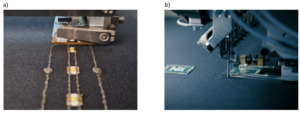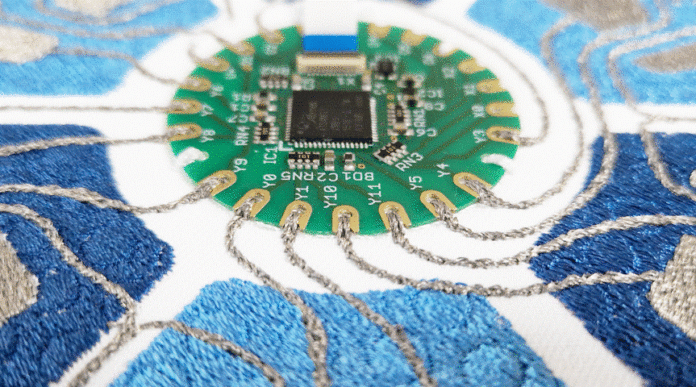“Revolutionizing Fabric: The Synergy of Smart and Technical Textiles in Modern Applications”
Hello, textile enthusiasts! Today we will delve deep into the intersection of textiles and technology, focusing on the realm of smart and technical textiles. This summary will bring together a wealth of insights and knowledge from a wide spectrum of sources, all aimed at giving you a comprehensive understanding of these innovative materials and their applications. Grab a cup of tea, get comfortable, and let’s embark on this textile adventure!

Understanding Smart Textiles**
In the world of textiles, smart textiles or e-textiles are nothing short of a revolution. They go beyond the aesthetic and comfort properties of traditional fabrics, integrating advanced technologies to provide additional functionalities. Smart textiles can sense environmental changes and respond to them, interact with the wearer, and do much more. Imagine a workout shirt that monitors your heart rate or a blanket that adjusts its temperature based on your body heat. These are just glimpses of what smart textiles are capable of.
Applications and Benefits**
The applications of smart textiles are far-reaching, encompassing various sectors such as healthcare, sports, military, fashion, and environmental monitoring. In healthcare, for instance, smart textiles can play a crucial role in patient monitoring, offering data on vital signs and other health indicators. For athletes, smart fabrics can track performance metrics, enhancing training and recovery processes. Military applications include uniforms that can adapt to environmental conditions and even provide life-saving information during combat.
But what makes these textiles truly smart? Let’s explore some of the key features:
Sensing:** Smart textiles can include embedded sensors that detect changes in the environment or the wearer’s condition. For example, pressure sensors in shoes can inform gait analysis.
Actuation:** Beyond sensing, some smart textiles can act on the data they gather. For example, a material may change its color based on temperature variations. Communication:** These textiles can often communicate data to other devices, such as smartphones or computers. This is particularly useful in healthcare applications where continuous monitoring data must be processed and analyzed.Creating Smart Textiles**
The creation of smart textiles involves integrating electronic components into the fabric without compromising its core properties. This can be achieved using conductive threads, microchips, and sensors. Conductive threads are perhaps the most critical element, as they form the electrical pathways necessary for the textile to perform its functions. These threads can be made from metals like silver or copper or modern composites that are more flexible and comfortable.
Let’s delve deeper into some specific technologies:
1. Conductive Yarns and Fibers:** These are fibers that can conduct electricity, allowing various electronic components embedded in the fabric to communicate with each other. They are essential for creating wearable technologies, as they can be woven into the fabric without affecting the wearer’s comfort.
2. Nano-Sensors:** Nanotechnology plays a significant role in smart textiles. Tiny sensors, smaller than a human hair, can be integrated into fabrics to sense a range of stimuli, from body temperature to environmental humidity. Their small size ensures they do not hinder the wearability of the textile.
3. Energy Harvesters:** One of the critical challenges in smart textiles is powering the electronic components. Energy harvesting techniques, such as solar cells or piezoelectric materials (which generate electricity from mechanical stress), are innovative solutions that provide the necessary energy for these devices to function.
4. Microcontrollers and Embedded Systems:** These are the brains of smart textiles. Microcontrollers can process data from sensors and control actuators to perform various functions. They are embedded within the fabric in a way that maintains its flexibility and functionality.
Market Trends and Future Directions**
The market for smart textiles is growing rapidly, driven by advancements in both textile technology and electronics. According to market research, the global smart textiles market is expected to reach a value of several billion dollars by the next decade, with significant growth in sectors like healthcare and sports.
Several trends are shaping the future of smart textiles:
Increased Integration with IoT:** The Internet of Things (IoT) is about connecting everyday objects to the internet, and smart textiles are perfectly positioned to be part of this revolution. Fabrics that can communicate with other smart devices will offer enhanced functionalities and user experiences.
Sustainability:** As with many industries, the push towards sustainable practices is influencing the development of smart textiles. Innovations include recyclable conductive materials and energy-efficient manufacturing processes. Personalization:** Consumer demand is driving the move towards personalized smart textiles. Customizable features, such as adaptive fit and individualized monitoring, are becoming increasingly common.Challenges to Overcome**
Despite the exciting potential, smart textiles face several challenges. Durability is a primary concern – the electronic components must withstand the same wear and care processes as the fabric itself, such as washing and stretching. Moreover, designers need to balance the functionality of the electronics with the comfort and aesthetics expected in clothing and other textile products.
Another challenge is the seamless integration of electronics without making the fabric too rigid or uncomfortable. Researchers are continually seeking new materials and methods to embed electronics into textiles effectively.
Technical Textiles: Broadening the Horizon**
Moving beyond smart textiles, let’s explore technical textiles, which encompass a broader category of high-performance fabrics used for specific functional applications. These aren’t just limited to electronic enhancements but include a wide range of materials engineered for performance in industries like automotive, aerospace, agriculture, and construction.
Key Areas and Innovations in Technical Textiles**
1. Protective Textiles:** Used in environments that demand safety and durability, such as firefighting, medical, and military applications. Innovations in this field include textiles with enhanced flame resistance, cut resistance, and antimicrobial properties.
2. Geotextiles:** These textiles are used in geotechnical engineering projects, such as road construction, erosion control, and soil stabilization. They help improve soil structure and reduce erosion, supporting infrastructure longevity.
3. Agro-textiles:** Designed to support and enhance agricultural activities, these textiles can provide benefits like pest control, weather protection, and improved crop yields. Examples include shading nets, anti-bird nets, and weed control fabrics.
4. Sports Textiles:** Specialized fabrics for sports applications include moisture-wicking materials, high-stretch fabrics, and garments that provide compressive support. These textiles not only enhance athletic performance but also contribute to the wearer’s comfort and safety.
5. Medical Textiles:** These include a range of products from simple bandages to complex implantable devices. Medical textiles are designed to meet strict regulatory standards for safety and biocompatibility.
Functional Finishes and Coatings**
One of the exciting advancements in technical textiles is the development of functional finishes and coatings. These treatments provide additional properties to the fabric, enhancing its performance for specific applications. Examples include:
Hydrophobic Coatings:** Make textiles water-resistant, ideal for outdoor and protective clothing.
Antimicrobial Treatments:** Prevent the growth of bacteria and fungi, essential in medical and hygiene products. UV Protection:** Fabrics treated to block ultraviolet rays, protecting the wearer from sun exposure.Sustainability in Technical Textiles**
As with smart textiles, sustainability is also a significant concern in the realm of technical textiles. Efforts to develop eco-friendly materials and processes include the use of biodegradable fibers, recycling initiatives, and minimizing the environmental impact of textile manufacturing.
Future Outlook**
The future of technical textiles looks promising, with continual advancements making these materials more efficient, durable, and versatile. Integration with smart technologies will further expand their capabilities, offering enhanced functionalities and applications.
Conclusion**
In wrapping up our exploration of smart and technical textiles, it’s clear that we stand at the forefront of a textile revolution. The marriage of traditional fabric craftsmanship with cutting-edge technology is pushing the boundaries of what textiles can achieve. From health monitoring to environmental protection, smart and technical textiles are poised to play crucial roles in various aspects of our lives.
The ongoing research and development in this field promise even more exciting innovations, making textiles not just a background component but a dynamic and interactive part of our daily experiences. As we move forward, the key will be to address the challenges head-on while leveraging the immense potential these advanced textiles offer.
Thank you for joining me on this fascinating journey into the world of smart and technical textiles. I hope this deep dive has sparked your interest and provided valuable insights into the incredible innovations shaping our future. Keep exploring, and stay tuned for more textile adventures!
Keywords: Smart Textiles**, Applications**, **Technology**, (Post number: 13), **Innovation**, **Sustainability**





